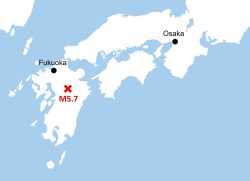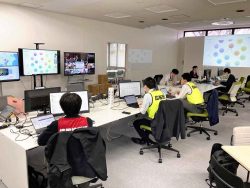
The National Institute of Infectious Diseases
17:23 JST, May 27, 2024
TOKYO (Jiji Press) — The number of patients of streptococcal toxic shock syndrome, a lethal infection caused by the bacteria behind strep throat, is rising at a record pace in Japan.
STSS, which can cause multiple organ failure and limb necrosis, has a mortality rate of about 30%.
Especially infectious strains are being increasingly detected, and experts are calling for heightened awareness particularly among the elderly, who are notably vulnerable to the infection.
Streptococcus bacteria are transmitted primarily through human contact and airborne droplets. Infected people often remain asymptomatic, but the bacterium can infiltrate blood and tissues such as muscle, occasionally leading to STSS.
Initial symptoms include fever and chills, and the infection can progress rapidly to cause a state of shock through a drop in blood pressure and multiple organ failure.
According to a preliminary report by the National Institute of Infectious Diseases, there were 941 STSS patients in Japan last year, the highest since current records began in 1999. The patient tally this year reached 851 as of May 12, up by about 2.8-fold from a year before.
Types of the streptococcus bacterium include the group A, group B and group G.
The M1UK strain, which spread in Britain in the 2010s, is a highly toxic strain of the group A bacteria and has been increasingly detected in areas including the Kanto region since the second half of last year.
The health ministry is strengthening its monitoring efforts, but the connection between the strain and the rise in STSS cases is unclear.
“Elderly individuals aged 65 and above constitute the majority of STSS patients,” Prof. Ken Kikuchi of Tokyo Women’s Medical University Hospital said. “Bacteria often enter through minor foot injuries such as shoe sores and rashes caused by athlete’s foot.”
Kikuchi called on people involved in elderly nursing to check daily whether elderly people’s feet are kept clean.
It is difficult to diagnose STSS in its early stages, often requiring symptom progression for accurate assessment.
Immediate responses are needed when patients’ feet swell rapidly and they develop fevers of 39 C or higher.
“The disease can be treated if antibiotics are administered early, but amputations of affected parts may become necessary if infections progress,” Kikuchi said. “People with severe symptoms should visit hospitals with inpatient services.”
"Society" POPULAR ARTICLE
-

M4.9 Earthquake Hits Tokyo, Neighboring Prefectures
-

M7.5 Earthquake Hits Northern Japan; Tsunami Waves Observed in Hokkaido, Aomori and Iwate Prefectures
-

Tsukiji Market Urges Tourists to Avoid Visiting in Year-End
-

Israeli Tourists Refused Accommodation at Hotel in Japan’s Nagano Pref., Prompting Protest by Israeli Embassy and Probe by Prefecture
-

M5.7 Earthquake Hits Japan’s Kumamoto Pref., Measuring Upper 5 Intensity, No Tsunami Expected
JN ACCESS RANKING
-

Keidanren Chairman Yoshinobu Tsutsui Visits Kashiwazaki-Kariwa Nuclear Power Plant; Inspects New Emergency Safety System
-

Imports of Rare Earths from China Facing Delays, May Be Caused by Deterioration of Japan-China Relations
-

University of Tokyo Professor Discusses Japanese Economic Security in Interview Ahead of Forum
-

Japan Pulls out of Vietnam Nuclear Project, Complicating Hanoi’s Power Plans
-

Govt Aims to Expand NISA Program Lineup, Abolish Age Restriction






















